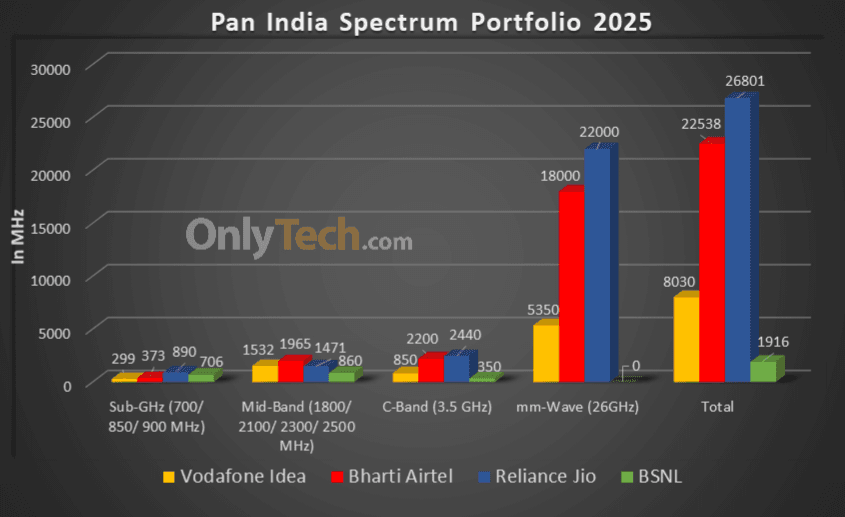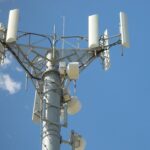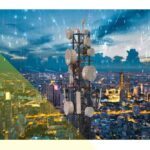Spectrum is for telecommunication what jet fuel is for aviation. Spectrum is a range of electromagnetic frequencies or airwaves that telecom companies use for establishing a connection between a cell tower and a mobile phone. The bandwidth of this spectrum is directly proportional to the speed of a wireless data network (since more data can be transmitted simultaneously through a broader data pipeline). In contrast, the frequency is inversely proportional to the coverage (since lower frequencies penetrate better through physical barriers and thus have wider coverage).
The spectrum holding data sheet embedded in this article represents the current spectrum holdings of all active telecom operators across all frequency bands across all 22 telecom circles along with their liberalisation status and expiry dates. All figures represented are in MHz. The value mentioned in the bracket beside the frequency at the base of each sheet is the band number where ‘B’ stands for 4G LTE band whereas ‘n’ stands for the corresponding 5G NR band.
The spectrum shown under BSNL and Aircel in white is reserved for the respective operators but has not yet been officially allotted to them.
Spectrum Liberalisation:
Spectrum was administratively allocated to operators in each of the 22 licensed service areas or circles prior to 2010, this spectrum is called non-liberalised and can only be used for 2G services whereas all airwaves allotted post-2010 have been through a Spectrum Auction where operators have paid the market discovered price and this spectrum is called liberalised and can be used for any technology platform 2G/3G/4G/5G. Alternatively, operators may choose to liberalise their administratively allotted spectrum by paying the market-discovered price to DoT on a pro-rata basis for the remaining validity of the spectrum.
Paired and Unpaired spectrum:
Spectrum may be paired or unpaired, bands 1/3/5/8/28 are all paired where one set of frequencies is used for uplink whereas another distinct set of frequencies is used for downlink known as Frequency-division duplexing (FDD), whereas bands 40/41/78/258 are unpaired where both uplink and downlink happens in the same set of frequencies separated by the time of uplink and downlink known as Time-division duplexing (TDD).
List of Indian FDD Bands:
| 4G LTE band | 5G NR band | Uplink frequency range (MHz) | Downlink frequency range (MHz) | Bandwidth for telecom (MHz) | Block size (MHz) |
|---|---|---|---|---|---|
| B1 | n1 | 1939-1979 | 2129-2169 | 40×2 | 5×2 |
| B3 | n3 | 1710-1780 | 1805-1875 | 70×2 | 0.2×2 |
| B5 | n5 | 824-844 | 869-889 | 20×2 | 1.25×2 |
| B8 | n8 | 890-915 | 935-960 | 25×2 | 0.2×2 |
| B28 | n28 | 723-733/ 738-748 | 778-788/ 793-803 | 20×2 | 5×2 |
List of Indian TDD Bands:
| 4G LTE band | 5G NR band | Frequency range (MHz) | Bandwidth for telecom (MHz) | Block size (MHz) |
|---|---|---|---|---|
| B40 | n40 | 2300-2380 | 80 | 10 |
| B41 | n41 | 2535-2555/ 2615-2655 | 60 | 10 |
| – | n78 | 3300-3670 | 370 | 10 |
| – | n258 | 24250-27500 | 3250 | 50 |
Spectrum caps:
A spectrum cap dictates how much spectrum a particular operator can hold in a circle for a specific band. There is a 40% cap for Sub-GHz spectrum in the 700/850/900 MHz bands combined, a 40% cap for Mid-Band spectrum in the 1800/2100/2300/2500 MHz bands combined, a 40% cap for the C-Band spectrum of 3300-3670 MHz and a 40% cap for the mm-Wave spectrum bands of 24.25-27.5 GHz. The current spectrum caps are denoted in the spectrum chart.
Overall spectrum holdings of operators (in MHz):
| Operator/Holding | Jio | Airtel | Vi | BSNL |
|---|---|---|---|---|
| Sub-GHz | 890 | 373.2 | 298.8 | 706 |
| Mid Band | 1470.8 | 1964.9 | 1531.6 | 860 |
| C-Band | 2440 | 2200 | 850 | 350 |
| mm-Wave Band | 22000 | 18000 | 5350 | 0 |
| Total | 26,800.8 | 22,538.1 | 8,030.4 | 1,916 |
Spectrum sharing/trading/leasing guidelines:
- Telecom operators holding CMTS/UASL/UL licenses can enter into a Spectrum-Sharing agreement with each other so long as both parties hold liberalised spectrum in the same band in the same circle. Spectrum sharing is possible only on a Pan LSA level in block sizes defined by DoT and only after one year of an operator acquiring the spectrum.
- Telecom operators holding CMTS/UASL/UL licenses can enter into a Spectrum-Trading agreement with each other so long as the spectrum being sold is liberalised. Trading of spectrum is possible only on a Pan LSA level in block sizes defined by DoT and only after two years of an operator acquiring the spectrum.
- Telecom operators may enter into a Spectrum-Leasing agreement only with Enterprises holding a Captive Non-Public Network (CNPN) license and not with each other. The lease may be limited to any geographic area within the LSA and for any duration mutually agreed upon by both parties. A CNPN licensee can lease spectrum from multiple operators within an LSA.
Note: We update this chart in real-time to ensure it is always up to date with the latest changes in spectrum holding. Certain human errors might have crept in during the manual compilation of the data, any mistakes/ rectification can be brought to the Team’s notice through the comments section below.








In the spectrum chart, across 900, 2100, 2500 bands for bsnl/mtnl, for several circles, there are many white boxes, mentioning liberalised or non-liberalised but withouth the expiry year mentioned.
What does this (white box) mean or signify… Not alloted spectrum or any other thing else?
see below ismail updated clarification
Spectrum shown in White denotes spectrum which has been reserved for BSNL but hasn’t been allotted yet. When it’s allotted it will be liberalised spectrum.
Esmail, your spectrum chart effort & knowlege sharing is commendable & greatly appreciated. Kudos to you.
My query & curiosity are listed below. Will be grateful if you could kindly share your knowledge of the same.
Why does BSNL have many major & important circles (like Delhi, Mumbai, Maharashtra, Tamil Nadu etc.) where spectrum in several bands (700, 2100, 2500) has been reserved (white boxes in spectrum chart) but still not alloted? When will these reserved specrum get alloted to BSNL? Do you have any confirmed info of the same?
Who decides when the allotment is to be made/needed – BSNL or DoT? What is the reason or basis for allotment to few circles only while others have not been alloted?
Based on all of the above, will the planned 1 lakh 4G sites of BSNL be spreaded across India in all circles or implemented only in few circles, leaving Delhi, Mumbai, Maharashta, Tamil Nadu etc. – where spectrum (700, 2500, bands) has not be alloted yet?
Thanks for the appreciation Ashok
As for the BSNL non allotted reserved spectrum, it’s the decision of DoT as to when, where and how much spectrum is to be allotted for smooth functioning of service.
As for Mumbai and Delhi, those circles come under MTNL jurisdiction not BSNL so the allotment may have to wait until both telcos are officially merged. As of now they are functionally merged with BSNL handling the operations of MTNL for the next 10 years.
For the other circles you mentioned like Maharashtra and Tamilnadu, right now BSNL has test spectrum in 700 MHz band which is valid till 30th September so before that expires, sometime this month itself they may be allotted the spectrum in the remaining circles at least in 700 and 2100 MHz bands since the official Pan India 4G rollout date is 15th October.
As for the 1 lakh 4G BTS target, it seems achievable by March 2025. Before that the 4G rollout will happen but the dense network coverage will happen only after the BTS are live in this quantity.
Esmail Sir, In the spectrum chart…
1.) For Bsnl/Mtnl, in Mumbai (& Delhi), in 900 band, 5 mhz is shown (in black color) as expired and 1.4 mhz is shown (in whie color) as non-liberalized. Is 1.4 mhz of 900 band being in active use and how much spectrum in 900 band is operational for Bsnl/Mtnl in Mumbai… 1.4mhz or more… Or is there no 900 band spectrum at all?
2.) For 2500 band, for Bsnl, certain circles are shown in brown color and certain circles in white color (like maharashtra, gujurat, tamil nadu, mumbai etc). Have circles in white color got (alloted) 2500 band spectrum and are they operational?
3.) Is Vi’s 30mhz spectrum in 2500mhz a continious single block or is it/will it work as Carrier Aggregation (of 20mhz+10mhz)?
Thanks in advance for your answers.
1) 5 MHz of spectrum in 900 MHz band in Mumbai and Delhi had expired in 2019 and has not been officially renewed for MTNL. It will get assigned to BSNL soon along with an additional 1.4 MHz making the bandwidth 6.4 MHz.
2) only the spectrum shown in brown is allotted to BSNL, the one shown in White is just reserved for them and will be allotted soon.
3) Yes Vi’s 30 MHz in 2500 MHz band is contiguous but if Vi wants to use it for 4G it will have to be deployed as 20 MHz+10 MHz since the maximum block size for 4G is 20 MHz. Though if vi wants to use it for 5G then it can deploy a continuous block of 30 MHz since the maximum block size for 5G is 100 MHz.